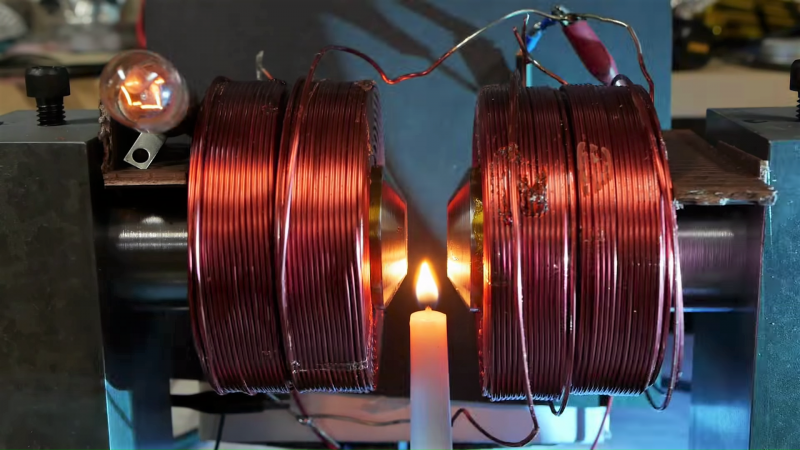More often than you think, scientific progress starts with a simple statement: “Huh, that’s funny…” That’s the sign that someone has noticed something peculiar, and that’s the raw fuel of science because it often takes the scientist down interesting rabbit holes that sometimes lead to insights into the way the world works.
[Ben Krasnow] ended up falling down one of those rabbit holes recently with his experiments with magnets and flames. It started with his look at the Zeeman effect, which is the observation that magnetic fields can influence the spectral lines of light emitted by certain sources. In a previous video, [Ben] showed that light from a sodium lamp could be dimmed by a powerful electromagnet. Some of his viewers took exception to his setup, which used an oxy-acetylene flame doped with sodium passing through the poles of the magnet; they thought the effect observed was a simple magnetohydrodynamic effect, and not the Zeeman effect he was supposed to be testing. That led to the experiments in the video below, which started with a candle flame being strongly deflected by the magnet. [Ben] methodically worked through the problem, eliminating variables by going so far as to blow soap bubbles of various gasses within the magnet’s poles to rule out the diamagnetism of oxygen as a cause of the phenomenon. He finally showed that even hot air by itself is deflected, using a simple light bulb and a FLIR camera. It’s good stuff, and well worth a watch.
Spoiler alert: [Ben] is still scratching his head about what’s going on, and we’re looking forward to his conclusions. This isn’t his first rabbit hole expedition, of course; his experiments with creating plasma with high-pressure water were fascinating, as were his DIY superconducting ceramics.

















Important to remember that magnetism is electricity’s evil twin. Anything electrically charged and moving will be affected by a magnetic field. See http://wtamu.edu/~cbaird/sq/2014/05/28/do-flames-contain-plasma/
+1 on the above. Convection moves the charged ions through a magnetic field so I’d expect an eddy current. What would seal it is if reversing the polaroty of the external field reversed the direction of deflection.
OK, that’s what I thought, too, but what about heated air rising from the light bulb? It was somewhat high temperature, but not enough to get ionized, otherwise we would see it glow (and burn the paper).
They might even be the same thing, under the hood.
The context looks different to humans, so we have different words.
The ARE the same thing under the hood: https://en.wikipedia.org/wiki/Classical_electromagnetism_and_special_relativity#Relationship_between_electricity_and_magnetism
I guess you’re technically correct, though, because “is” ∈ “might be”.
Veratasium did a video on this..
https://youtu.be/a7_8Gc_Llr8?t=3
The flame is a conductor with current flowing due to convection. Connect a high voltage supply with one electrode on the flame and another above it. Static current, no sparks. The flame will not only grow but curve due to the magnetic field. Right-hand rule.
I think, the flame is deflected, because the burning gas is ionized. So you have a moving charge and this can be influenced by a magnetic field. Like in IBAD or IAD (ion beam assisted deposition) in PVD (physical vapor Deposition) chambers to harden the layers with ion bombardment.
You to me / Like a magnet to a flame
https://www.youtube.com/watch?v=gMbnJzHhoBI
This.
bender and magnets equals crazy country songs :)
“Oooooohhhhhh, she’ll be coming round the mountain when she comes!”
I admire this kind of work – I try to do the same sort of thing in my own field (I’m just nowhere near as good at presenting it all).
Anyone who does science for real lives for this kind of thing – this is what gets us going.
There may indeed be effects due to ion/H-field interactions – that IS something I do here. But hot air is hardly ionized, it’s a bunch of orders of magnitude too cool for that. And yet, it moves (not to coin a phrase ;).
Sweet. Add some electrodes that stick into the flame, apply voltage (at right angle to the magnetic field) and you have yourself a little MHD accelerator.
I’ve made tweeters this way. The more ionized the flame, the better. Like a sodium-doped oxy-acetylene flame, which sadly, hisses so it’s more of a “it’s cool you can do it at all” kind of thing. I’d never noticed the effect he shows here, but then I didn’t have that many Gauss (sorry for old-guy units) by a long shot, and never tried with a relatively “low pressure/velocity” candle flame either.
I do fusor-type fusion (hence the nick here) and indeed ions are moved all around and behavior changed even from outside the vacuum system by a handheld magnet, I’ve even done youtube videos on it – cool to watch, but there the mechanism is obvious, here…not so much.
awesome demo! it makes me uneasy that the magnet moves. i love that the indicator lightbulb moves too. and i’m really uncomfortable about burning the insulation off the magnet wire.
I agree! I love [Ben Krasnow]’s experiments. Awesome experiment and I respect letting the data and questions be your guide rather than trying to meet a schedule.
I think the mass of the electromagnet is large enough that he can experiment for quite a while without raising the temperature of the core very much.
This reminds me of the flame triode. https://hackaday.com/2016/05/26/flame-triodes-dont-need-any-vacuum/
Some research papers on the topic:
https://ieeexplore.ieee.org/abstract/document/1065242/
https://aip.scitation.org/doi/abs/10.1063/1.343016
Gas plasma is diamagnetic if you have not figured it out already.
No, it’s not.
this guy got it all solved:
https://www.youtube.com/watch?v=byqSoOrCmxU
;/
That’s a bunch of pseudoscience garbage.
I believe the mid-product of combustion contains a lot of ions
Finally some real science.
Don’t forget, flames conduct electricity.
Hence flame diodes/triodes/bridge rectifiers extra.
If you apply a magnetic field, there will be a current induced in the flame. The flame is moving.
It’s a similar effect with his high pressure water experiment.
In that experiment he is effectively making a homopolar generator with the water and the surface.